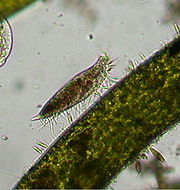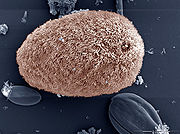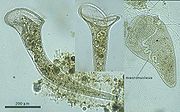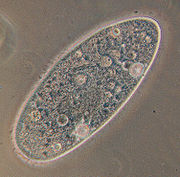- Ciliata (Classification Phylogénétique)
-
Ciliata (classification phylogénétique)
Cette page a pour objet de présenter un arbre phylogénétique des Ciliata (ou Ciliophora, ou encore Ciliés), c'est-à-dire un cladogramme mettant en lumière les relations évolutives complexes (relations groupes ancestraux - groupes descendants) existant entre les différents organismes vivants ou taxa, constituant ce groupe. Du fait de ses méthodes nouvelles basées sur la biologie moléculaire, la phylogénie, science récente à l'origine de la classification phylogénétique du vivant, est en plein essor et propose parfois des résultats en contradiction avec l'ancienne classification, majoritairement basée, elle, sur des critères morphologiques et physiologiques. Aussi, certains points particuliers font parfois encore l'objet de débats au sein de la communauté scientifique. L'objectif, s'il y a lieu, est également de présenter ces derniers ici.
Ce cladogramme présente aussi bien les groupes encore représentés aujourd'hui que ceux qui sont éteints (incluant les groupes fossiles).
À la suite d'un taxon, sa période d'apparition, quand elle est connue, peut être indiquée suivant la légende suivante : (Plé) : Pléistocène ; (Pli) : Pliocène ; (Mio) : Miocène ; (Oli) : Oligocène ; (Éoc) : Éocène ; (Pal) : Paléocène ; (Cré) : Crétacé ; (Jur) : Jurassique ; (Tri) : Trias ; (Per) : Permien ; (Car) : Carbonifère ; (Dév) : Dévonien ; (Sil) : Silurien ; (Ord) : Ordovicien ; (Camb) : Cambrien. De plus, pour plus de précisions si possible, (-) : inférieur ; (~) : moyen ; (+) : supérieur.
Le symbole ▲ renvoie à la partie immédiatement supérieure de l'arbre phylogénétique du vivant. Le signe ► renvoie à la classification phylogénétique du groupe considéré.
Sommaire
Arbre phylogénétique
Arbre résumé
▲ └─o Ciliophora ou Ciliata ├─o Postciliodesmatophora │ ├─o Karyorelictea │ └─o Heterotrichea └─o Intramacronucleata ├─o Spirotrichea │ ├─o Hypotrichia │ ├─o Stichotrichia │ ├─o Oligotrichia │ └─o Choreotrichia ├─o Litostomatea │ ├─o Trichostomatia │ └─o Haptoria ├─o Phyllopharyngea │ ├─o Phyllopharyngia │ ├─o Rhynchodia │ ├─o Chonotrichia │ └─o Suctoria ├─o Nassophorea ├─o Colpodea ├─o Prostomatea ├─o Plagiopylida └─o Oligohymenophorea ├─o Apostomatia ├─o Peritrichia ├─o Astomatida └─o Scuticociliatia
Arbre développé
Arbre développé▲ └─o Ciliophora ou Ciliata ├─o Exocolpodidae ├─o Postciliodesmatophora │ ├─o Karyorelictea │ │ ├─o Protostomatida │ │ │ ├─o Kentrophoridae │ │ │ └─o Trachelocercidae │ │ ├─o Protoheterotrichida ou Geleiidae │ │ └─o Loxodida │ │ ├─o Loxodidae │ │ └─o Cryptopharyngidae │ └─o Heterotrichea │ ├─o Licnophorida │ └─o Heterotrichida │ ├─o Folliculinidae │ ├─o Peritromidae │ ├─o Stentoridae │ ├─o Blepharismidae │ ├─o Spirostomidae │ ├─o Condylostomatidae │ └─o Climacostomidae └─o Intramacronucleata ├─o Spirotrichea │ ├─? Armophorida │ │ ├─o Metopidae │ │ └─o Caenomorphidae │ ├─? Phacodiniida │ ├─? Odontostomatida │ │ ├─o Mylestomatidae │ │ ├─o Discomorphellidae │ │ └─o Epalxellidae │ ├─? Clevelandellida │ │ ├─o Clevelandellidae │ │ ├─o Nyctotheridae │ │ ├─o Sicuophoridae │ │ └─o Neonyctotheridae │ ├─o Protocruziidia │ ├─o Hypotrichia │ │ ├─o Kiitrichida │ │ │ ├─? Transitellidae │ │ │ └─o Kiitrichidae │ │ └─o Euplotida │ │ ├─o Discocephalina │ │ │ ├─o Erionellidae │ │ │ └─o Discocephalidae │ │ └─o Euplotina │ │ ├─o Uronychiidae │ │ ├─o Aspidiscidae │ │ ├─o Certesiidae │ │ ├─o Gastrocirrhidae │ │ └─o Euplotidae │ ├─o Stichotrichia │ │ ├─o Plagiotomida │ │ ├─o Urostylida │ │ │ ├─o Urostylidae │ │ │ ├─o Pseudourostylidae │ │ │ └─o Pseudokeronopsidae │ │ ├─o Sporadotrichida │ │ │ ├─o Trachelostylidae │ │ │ └─o Oxytrichidae │ │ └─o Stichotrichida │ │ ├─o Spirofilidae │ │ ├─o Psilotrichidae │ │ ├─o Keronidae │ │ ├─o Epiclintidae │ │ ├─o Amphisiellidae │ │ └─o Kahliellidae │ ├─o Oligotrichia │ │ ├─o Halteriida │ │ └─o Strombidiida │ └─o Choreotrichia │ ├─o Choreotrichida │ │ ├─o Strobilidiidae │ │ ├─o Strombidinopsidae │ │ ├─o Leegaardiellidae │ │ └─o Lohmanniellidae │ └─o Tintinnida │ ├─o Dictyocystidae │ ├─o Tintinnidiidae │ ├─o Codonellidae │ ├─o Codonellopsidae │ ├─o Nolaclusiliidae │ ├─o Metacylididae │ ├─o Ascampbelliellidae │ ├─o Epiplocylididae │ ├─o Rhabdonellidae │ ├─o Ptychocylidae │ ├─o Petalotrichidae │ ├─o Cyttarocylididae │ ├─o Xystonellidae │ ├─o Undellidae │ └─o Tintinnidae ├─o Litostomatea │ ├─o Trichostomatia │ │ ├─o Coelosomidae │ │ ├─o Trichospiridae │ │ ├─? Macropodiniidae │ │ ├─o Vestibuliferida │ │ │ ├─o Paraisotrichidae │ │ │ ├─o Amylovoracidae │ │ │ ├─o Isotrichidae │ │ │ ├─o Balantidiidae │ │ │ └─o Pycnotrichidae │ │ └─o Entodiniomorphida │ │ ├─o Buetschliidae ou Archistomatina │ │ ├─o Blepharocorythidae │ │ └─o Entodiniomorphina │ │ ├─o Ophryoscolecidae │ │ ├─o Cycloposthiidae │ │ ├─o Spirodiniidae │ │ └─o Troglodytellidae │ └─o Haptoria │ ├─o Cyclotrichida ou Mesodiniidae │ ├─o Pleurostomatida │ │ ├─o Amphileptidae │ │ └─o Litonotidae │ └─o Haptorida │ ├─o Pseudoholophryidae │ ├─o Didiniidae │ ├─o Pseudotrachelocercidae │ ├─o Actinobolinidae │ ├─o Tracheliidae │ ├─o Helicoprorodontidae │ ├─o Pleuroplitidae │ ├─o Lacrymariidae │ ├─o Homalozoonidae │ ├─o Enchelyidae │ ├─o Acropisthiidae │ ├─o Fuscheriidae │ ├─o Spathidiidae │ ├─o Enchelyodontidae │ └─o Trachelophyllidae ├─o Phyllopharyngea │ ├─o Phyllopharyngia │ │ ├─o Dysteriida │ │ │ ├─o Kyaroikeidae │ │ │ ├─o Plesiotrichopidae │ │ │ ├─o Hartmannulidae │ │ │ └─o Dysteriidae │ │ └─o Chlamydodontida │ │ ├─o Kryoprorodontidae │ │ ├─o Chitonellidae │ │ ├─o Gastronautidae │ │ ├─o Chlamydodontidae │ │ ├─o Chilodonellidae │ │ └─o Lynchellidae │ ├─o Rhynchodia │ │ ├─o Hypocomatida ou Hypocomidae │ │ └─o Rhynchodida │ │ ├─o Sphenophryidae │ │ └─o Ancistrocomidae │ ├─o Chonotrichia │ │ ├─o Cryptogemmida │ │ │ ├─o Actinichonidae │ │ │ ├─o Isochonopsidae │ │ │ ├─o Isochonidae │ │ │ ├─o Inversochonidae │ │ │ ├─o Stylochonidae │ │ │ └─o Echinichonidae │ │ └─o Exogemmida │ │ ├─o Phyllochonidae │ │ ├─o Chilodochonidae │ │ ├─o Spirochonidae │ │ ├─o Filichonidae │ │ ├─o Heliochonidae │ │ └─o Lobochonidae │ └─o Suctoria │ ├─o Evaginogenida │ │ ├─o Cyathodiniidae │ │ ├─o Dendrocometidae │ │ └─o Discophryidae │ ├─o Endogenida │ │ ├─o Dendrosomatidae │ │ ├─o Trichophryidae │ │ ├─o Enchelyomorphidae │ │ ├─o Endosphaeridae │ │ ├─o Acinetidae │ │ └─o Tokophryidae │ └─o Exogenida │ ├─o Phalacrocleptidae │ ├─o Stylostomatidae │ ├─o Rhabdophryidae │ ├─o Ophryodendridae │ ├─o Spelaeophryidae │ ├─o Ephelotidae │ ├─o Parapodophryidae │ ├─o Podophryidae │ ├─o Tachyblastonidae │ ├─o Metacinetidae │ ├─o Thecacinetidae │ ├─o Paracinetidae │ ├─o Urnulidae │ └─o Corynophryidae ├─o Nassophorea │ ├─o Colpodidiida │ ├─o Microthoracida │ │ ├─o Discotrichidae │ │ ├─o Microthoracidae │ │ └─o Pseudomicrothoracidae │ ├─o Nassulida │ │ ├─o Nassulidae │ │ ├─o Furgasoniidae │ │ └─o Paranassulidae │ └─o Synhymeniida │ ├─o Nassulopsidae │ ├─o Synhymeniidae │ ├─o Orthodonellidae │ └─o Scaphidiodontidae ├─o Colpodea │ ├─? Pseudochlamydonellidae │ ├─? Tectohymenidae │ ├─o Bryophryida │ ├─o Cyrtolophosidida │ │ ├─o Cyrtolophosididae │ │ ├─o Sagittariidae (Ciliata) │ │ ├─o Woodruffiidae │ │ └─o Platyophryidae │ ├─o Bursariomorphida │ │ ├─o Bursariidae │ │ └─o Bursaridiidae │ ├─o Sorogenida │ ├─o Bryometopida │ │ ├─o Jaroschiidae │ │ ├─o Trihymenidae │ │ ├─o Bryometopidae │ │ └─o Kreyellidae │ └─o Colpodida │ ├─o Grossglockneriidae │ ├─o Marynidae │ ├─o Colpodidae │ ├─o Hausmanniellidae │ └─o Bardeliellidae ├─o Prostomatea │ ├─o Prostomatida │ │ ├─o Apsiktratidae │ │ └─o Metacystidae │ └─o Prorodontida │ ├─o Plagiocampidae │ ├─o Malacophryidae │ ├─o Balanionidae │ ├─o Urotrichidae │ ├─o Placidae │ ├─o Colepidae │ ├─o Lagynidae │ ├─o Prorodontidae │ └─o Holophryidae ├─o Plagiopylida │ ├─o Trimyemidae │ ├─o Sonderiidae │ └─o Plagiopylidae └─o Oligohymenophorea ├─o Peniculida │ ├─o Parameciina │ │ ├─o Urocentridae │ │ ├─o Neobursaridiidae │ │ └─o Parameciidae │ └─o Frontoniina │ ├─o Lembadionidae │ ├─o Maritujidae │ ├─o Stokesiidae │ ├─o Clathrostomatidae │ └─o Frontoniidae ├─o Hymenostomatida │ ├─o Ophryoglenina │ │ ├─o Ichthyophthiriidae │ │ └─o Ophryoglenidae │ └─o Tetrahymenina │ ├─o Curimostomatidae │ ├─o Spirozonidae │ ├─o Tetrahymenidae │ ├─o Turaniellidae │ └─o Glaucomidae ├─o Apostomatia │ ├─o Pilisuctorida ou Conidophryidae │ ├─o Astomatophorida ou Opalinopsidae │ └─o Apostomatida │ ├─o Colliniidae │ ├─o Foettingeriidae │ └─o Cyrtocaryidae ├─o Peritrichia │ ├─o Mobilida │ │ ├─o Trichodinidae │ │ ├─o Urceolariidae │ │ ├─o Leiotrochidae │ │ ├─o Polycyclidae │ │ └─o Trichodinopsidae │ └─o Sessilida │ ├─o Termitophryidae │ ├─o Astylozoidae │ ├─o Opisthonectidae │ ├─o Ophrydiidae │ ├─o Vaginicolidae │ ├─o Ellobiophryidae │ ├─o Lagenophryidae │ ├─o Usconophryidae │ ├─o Rovinjellidae │ ├─o Vorticellidae │ ├─o Zoothamniidae │ ├─o Operculariidae │ ├─o Scyphidiidae │ └─o Epistylididae ├─o Astomatida │ ├─o Archiastomatidae │ ├─o Anoplophryidae │ ├─o Haptophryidae │ ├─o Clausilocolidae │ ├─o Maupasellidae │ ├─o Intoshellinidae │ ├─o Contophryidae │ ├─o Radiophryidae │ └─o Hoplitophryidae └─o Scuticociliatia ├─o Thigmotrichida │ ├─o Ancistridae │ ├─o Hemispeiridae │ ├─o Hysterocinetidae │ └─o Paraptychostomidae ├─o Pleuronematida │ ├─o Calyptotrichidae │ ├─o Ctedoctematidae │ ├─o Histiobalantiidae │ ├─o Peniculistomatidae │ ├─o Pleuronematidae │ ├─o Dragescoidae │ ├─o Cyclidiidae │ ├─o Conchophthiridae │ └─o Thigmocomidae └─o Philasterida ├─o Thigmophryidae ├─o Urozonidae ├─o Cinetochilidae ├─o Loxocephalidae ├─o Pseudocohnilembidae ├─o Uronematidae ├─o Entorhipidiidae ├─o Entodiscidae ├─o Cryptochilidae ├─o Cohnilembidae ├─o Philasteridae ├─o Thyrophylacidae ├─o Paralembidae ├─o Orchitophryidae └─o Parauronematidae
Débat scientifique relatif à la phylogénie des Ciliata
Classification proposée par Adl et al. 2005
Ce comité a proposé une nouvelle classification, remplaçant celle des anciens Protistes et tenant compte des phylogénies moléculaires récentes. Elle regroupe les Eucaryotes en six groupes réputés monophylétiques. Voici ce qui concerne les Ciliophora ou Ciliata.
Classification proposée par Adl et al. 2005▲ └─o Ciliophora ├─o Postciliodesmatophora │ ├─o Karyorelictea │ └─o Heterotrichea └─o Intramacronucleata ├─o Spirotrichea │ ├─o Protocruzia │ ├─o Phacodinium │ ├─o Licnophora │ ├─o Hypotrichia │ ├─o Oligotrichia │ ├─o Choreotrichia │ └─o Stichotrichia ├─o Armophorea │ ├─o Armophorida │ ├─o Clevelandellida │ └─o Odontostomatida ├─o Litostomatea │ ├─o Haptoria │ └─o Trichostomatia ├─o Phyllopharyngea │ ├─o Cyrtophoria │ ├─o Chonotrichia │ ├─o Rhynchodia │ └─o Suctoria ├─o Nassophorea ├─o Colpodea ├─o Prostomatea ├─o Plagiopylea └─o Oligohymenophorea ├─o Peniculia ├─o Scuticociliatia ├─o Hymenostomatia ├─o Apostomatia ├─o Peritrichia └─o Astomatia
En savoir plus
Sources bibliographiques de référence
- Sina M. Adl et alii (2005) « The New Higher Level Classification of Eukaryotes », J. Eukaryot. Microbiol., 52 (5), p. 399–451
Autres sources bibliographiques
Sources internet
Liens internes
- Ciliata -- Ciliophora -- Cilié
- Eukaryota (classification phylogénétique)
- Arbre phylogénétique
- Photo-guide taxinomique du monde végétal
- Répertoire général des ressources en botanique
 Stylonychia sp.
Stylonychia sp.
- Portail de l’origine et de l’évolution du vivant
- Portail de la microbiologie
- Portail de la zoologie
Catégories : Eucaryotes (classification phylogénétique) | Zooplancton
Wikimedia Foundation. 2010.



